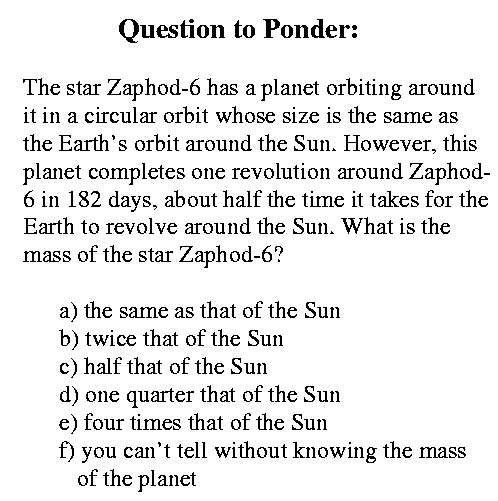|
|
Tiger! Tiger! burning bright In the forests of the night, What immortal hand or eye Could frame thy fearful symmetry? In what distantdeeps or skies Burnt the fire of thine eyes? William Blake, Songs of Experience, The Tiger |
Assignments:Read Chapter 25, Sections 4 and 5Don't forget about the Observing Lab!
|

In Class:
-----------------
star clusters:
we've done individual stars to death, so let's start looking at clusters
of stars.
- talked about stars liking to be members of binary systems
- also true for larger aggregations, too
- stars like partners
- star clusters are found all over the sky
- not all stars are members of clusters, but many are
- probably an accident of birth
- stars like to form in groups, it seems
whatever the cause, we have a bunch of stars all together in space
- i.e., all at the same distance from us.
- Hertzsprung made use of these beasts to create H-R diagrams for
clusters without knowing the distance
- y-axis is just flux.
- directly related to luminosity, since f = L/4piR2
- but not luminosity
- still works just fine, since all of the distances
are the same
But what if we knew the luminosity of a G star?
- how?
- maybe from measuring the flux from G stars whose distance we know
- then we could figureo ut the distance to a Pleiades G star
and get the distance t all of hte stars in the cluster
- then we could relabel the axis with luminosity
- that is, we can assign luminosities to stars in the cluster with
measured fluxes.
- aha! then now we can calculate the distance
to the cluster.
- how? f = L/4piR^2
Can do this with any star:
- measure spectrum --> get spectral type
- look up luminosity for MS stars of that spectral type
- measure flux
- used f = L/4piR^2 to get the distance
>>>> only dangerous part is assuming MS star
- most are, but some are off the MS
- giants or white dwarfs
- if you mistakenly assumed that these were MS stars
- you would calculate the wrong distance
With a cluster it's easier
- lots of stars define the MS
- pretty unambiguous
- lots of chances to check it, too
- compare F star flux with F star luminosity
- compare K star flux with K star luminosity, etc.
unfortunate name: spectroscopic parallax
- spectroscopic because you need spectral type
- but there's no parallax measurement about it
- DISTANCE is determined by the distance dimming,
or inverse square law ONLY
Using this method, you can construct proper H-R diagrams for lots of clusters
of stars
- using luminosity as the y-axis
- by definition, the MS will be in the same place for each cluster.
- so the H-R diagrams of all clusters should look the same
They don't
Pleadies star cluster
- well defined Main Sequence
- nearly all stars on it
Praesepe
- still a pretty good Main Sequence
- most stars on it
- shorter, though -- really hot stars missing
- and look at those giants
Messier 67
- very short Main Sequence
- still lots of stars on it
- extends only up to spectral type F or so
- lots of red giants and stuff with large radii
What's going on here?
remember how we once thought all stars were different because
of their myriad of different spectral lines?
- we're in the same boat again with clusters
- they should all look the same, but they don't
just as we searched for a single parameter or variable to explaiin
all of the differences in all of the spectra
(and found it --> temperature)
we would like to find a single factor responsible for all of
the variation we see in the structure of the HR diags
for all of these clusters
Need to explain:
- presence/absence of hottest stars
- length of the MS
- absence presence of giant stars
What is it about a cluster of stars that could differ from cluster to cluster
- I can think of three possibilities
1) composition
- long thought to be the culprit (as it was with star spectra)
- maybe you need something special to make hot stars
- zinc or something that allows hot stars to stay stable
- maybe contaminants in the coolest stars force them to
"puff up" and become giants
2) formation mechanism
- how stars form has been (and still is) poorly understood
- maybe the conditions under whch the stars formed are
only occasionally conducive to the formation of the hottest
stars
maybe failed hot stars are the giants
3) age
- stars don't live forever
- clusters are groups of stars that all formed together
- maybe we're just looking at the same cluster in different
times of life.
- consider nursery school/college/retirement home
for people
- all would look very different
- yet all are snapshots of common-aged people
at different times in their lives
- if the nursery schoolers stuck together
in a few years, they'd look like college
students.
|
![]()